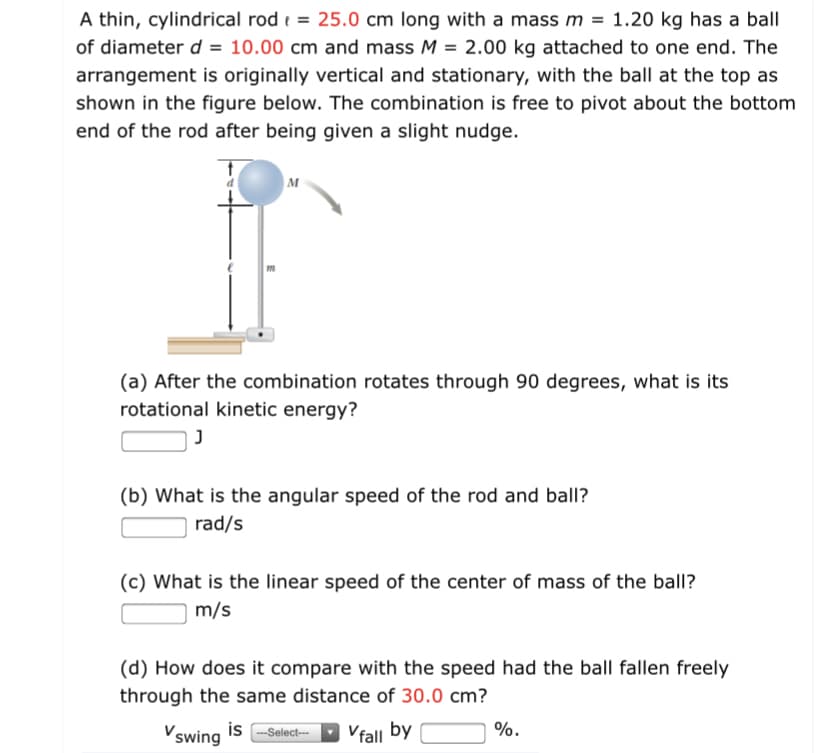A thin, cylindrical rod i = 25.0 cm long with a mass m = 1.20 kg has a ball of diameter d = 10.00 cm and mass M = 2.00 kg attached to one end. The %3D arrangement is originally vertical and stationary, with the ball at the top as shown in the figure below. The combination is free to pivot about the bottom end of the rod after being given a slight nudge. M (a) After the combination rotates through 90 degrees, what is its rotational kinetic energy? (b) What is the angular speed of the rod and ball? rad/s (c) What is the linear speed of the center of mass of the ball? m/s (d) How does it compare with the speed had the ball fallen freely through the same distance of 30.0 cm? V swing is Vfall by %. --Select--
A thin, cylindrical rod i = 25.0 cm long with a mass m = 1.20 kg has a ball of diameter d = 10.00 cm and mass M = 2.00 kg attached to one end. The %3D arrangement is originally vertical and stationary, with the ball at the top as shown in the figure below. The combination is free to pivot about the bottom end of the rod after being given a slight nudge. M (a) After the combination rotates through 90 degrees, what is its rotational kinetic energy? (b) What is the angular speed of the rod and ball? rad/s (c) What is the linear speed of the center of mass of the ball? m/s (d) How does it compare with the speed had the ball fallen freely through the same distance of 30.0 cm? V swing is Vfall by %. --Select--
Mechanics of Materials (MindTap Course List)
9th Edition
ISBN:9781337093347
Author:Barry J. Goodno, James M. Gere
Publisher:Barry J. Goodno, James M. Gere
Chapter3: Torsion
Section: Chapter Questions
Problem 3.4.17P: .17 A mountain-bike rider going uphill applies torque T = Fd(F = l5lb, d = 4 in.) to the end of the...
Related questions
Question

Transcribed Image Text:A thin, cylindrical rod e = 25.0 cm long with a mass m = 1.20 kg has a ball
of diameter d = 10.00 cm and mass M = 2.00 kg attached to one end. The
arrangement is originally vertical and stationary, with the ball at the top as
shown in the figure below. The combination is free to pivot about the bottom
%3D
end of the rod after being given a slight nudge.
M
(a) After the combination rotates through 90 degrees, what is its
rotational kinetic energy?
(b) What is the angular speed of the rod and ball?
rad/s
(c) What is the linear speed of the center of mass of the ball?
m/s
(d) How does it compare with the speed had the ball fallen freely
through the same distance of 30.0 cm?
Vswing is -Select--
Vfall by
%.
Expert Solution
This question has been solved!
Explore an expertly crafted, step-by-step solution for a thorough understanding of key concepts.
This is a popular solution!
Trending now
This is a popular solution!
Step by step
Solved in 2 steps

Knowledge Booster
Learn more about
Need a deep-dive on the concept behind this application? Look no further. Learn more about this topic, mechanical-engineering and related others by exploring similar questions and additional content below.Recommended textbooks for you

Mechanics of Materials (MindTap Course List)
Mechanical Engineering
ISBN:
9781337093347
Author:
Barry J. Goodno, James M. Gere
Publisher:
Cengage Learning

Mechanics of Materials (MindTap Course List)
Mechanical Engineering
ISBN:
9781337093347
Author:
Barry J. Goodno, James M. Gere
Publisher:
Cengage Learning